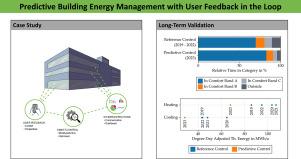Predictive building energy management with user feedback in the loop
IF 5.4
Q2 ENERGY & FUELS
引用次数: 0
Abstract
Retrofitting buildings with predictive control strategies can reduce their energy demand and improve thermal comfort by considering their thermal inertia and future weather conditions. A key challenge is minimizing additional infrastructure, such as sensors and actuators, while ensuring user comfort at all times. This study focuses on retrofitting with intelligent software, incorporating the users’ feedback directly into the control loop. We propose a predictive control strategy using an optimization-based energy management system (EMS) to control thermal zones in an office building. It uses a physically motivated grey-box model to predict and adjust thermal demand, with individual zones modelled using an RC-approach and parameter estimation handled by an unscented Kalman filter (UKF). This reduces deployment effort as the parameters are learned from historical data. The objective function ensures user comfort, penalizes undesirable behaviour and minimizes heating and cooling costs. An internal comfort model, automatically calibrated with user feedback by another UKF, further improves system performance. The practical case study is an office building at the ”Innovation District Inffeld”. Operation of the system for one year yielded significant results compared to conventional control. Thermal comfort was improved by 12% and thermal energy consumption for heating and cooling was reduced by about 35%.

以用户反馈为环路的预测性楼宇能源管理
采用预测性控制策略对建筑物进行改造,可以通过考虑建筑物的热惯性和未来的天气条件,减少能源需求并提高热舒适度。一个关键的挑战是在确保用户舒适度的同时,尽量减少额外的基础设施,如传感器和执行器。本研究的重点是利用智能软件进行改造,将用户的反馈直接纳入控制回路。我们提出了一种预测控制策略,使用基于优化的能源管理系统(EMS)来控制办公楼的热区。该系统采用物理激励灰箱模型来预测和调整热需求,单个区域采用 RC 方法建模,参数估计由无香味卡尔曼滤波器(UKF)处理。由于参数是从历史数据中学习的,因此减少了部署工作量。目标函数可确保用户舒适度,抑制不良行为,并最大限度地降低供暖和制冷成本。内部舒适度模型通过另一个 UKF 根据用户反馈进行自动校准,进一步提高了系统性能。实际案例研究是 "Inffeld 创新区 "的一栋办公楼。与传统控制相比,该系统运行一年后取得了显著效果。热舒适度提高了 12%,供暖和制冷的热能消耗减少了约 35%。
本文章由计算机程序翻译,如有差异,请以英文原文为准。
求助全文
约1分钟内获得全文
求助全文

 求助内容:
求助内容: 应助结果提醒方式:
应助结果提醒方式:


